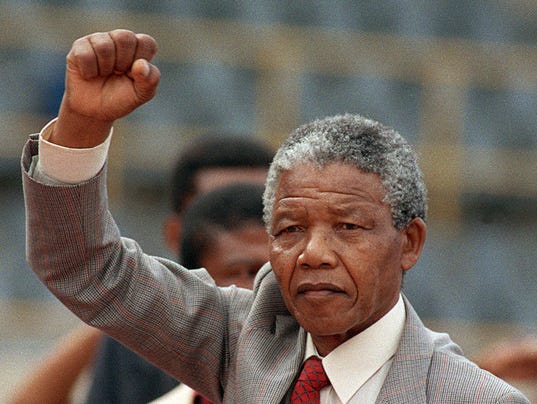Today, as the world reels from sectarian violence, attempted coup-de-tats and racial animus, Nelson Rolihlahla Mandela would have celebrated his 98th birthday. It is at such times that we truly begin to realize what the world is missing.
For most of us, what’s missing is perspective. A look back on the varying philosophies of Nelson Mandela provides tons of it.
During his early years, Mandela, an attorney, was an advocate of using nonviolent tactics to shame the apartheid government of South Africa into loosening its grip upon the lives and hopes of Black South Africans. However, after repeatedly watching his friends and allies in the African National Congress and South African Indian Congress be repeatedly brutalized by South African police, Mandela began to waver on his dedication to such tactics.

(Photo Credit: USA Today)
By 1953, he’d come to realize that a different approach was needed.
He verbally supported a groundswell of young Black South Africans who wished to take up arms from 1953 onward, but did not actively move to militarize the ANC until after the Sharpeville massacre of 1960, in which police killed 69 protesters. This was against the wishes of then ANC president Albert Luthuli, who Mandela said was out of touch with reality.
Umkhonto we Sizwe, or Spear of the Nation, was founded in 1961 and would become the African National Congress’ paramilitary wing. Its first attack was carried out later that year. Mandela himself would be trained in weaponry and guerrilla tactics in Ethiopia and Algeria in 1962.
In 1964, he and several other members of the ANC were tried and sentenced to life in prison on charges of sabotage and treason. He was offered freedom in exchange for renouncing violence on more than one occasion. He refused each time.
As he sat in prison, mostly in solitary confinement, the ANC carried out hundreds of bomb attacks against the apartheid regime.

(Photo Credit: USA Today)
In 1985, 21 years after he was sent to prison, Mandela began sending letters to the apartheid government heads to begin peace talks in which he was able to persuade the government to end apartheid. Spear of the Nation ceased violent acts in 1990 as talks continued.
Mandela was released the same year by F.W. de Klerk and would be voted in as president of South Africa in four years. Unlike Martin Luther King, Jr and Mahatma Ghandi, both of whom outright rejected violence as a means to gain freedom for their respective constituencies, Mandela supported its use against a brutal, philosophically unwavering regime of white supremacy.
He went from nonviolent protester to insurgency leader, from prisoner of the state to president of South Africa. Today, as terrorist bombs go off all of the world, as millions fight for their human rights, as protests strangle traffic in America’s largest metropolises, and as we silently cringe at the thought of what pain and misery a prolonged bloody anti-law enforcement campaign would cause to the land we love, Nelson Mandela’s life – his entire life – is as glaring an example for proponents of peace as it is for those who would readily take the opposite approach.

(Photo Credit: USA Today)
People have dignity, people have inherent human rights and people have pride. Denying a peoples’ access to any of those for an extended period of time is recipe for eventual disaster.
Mandela would serve as president of South Africa from 1994 to 1999 after which time he spent the majority of his time as a philanthropist and continually spoke against human rights abuses across the globe.
He died December 5, 2013 as one of the most beloved men in the world.
